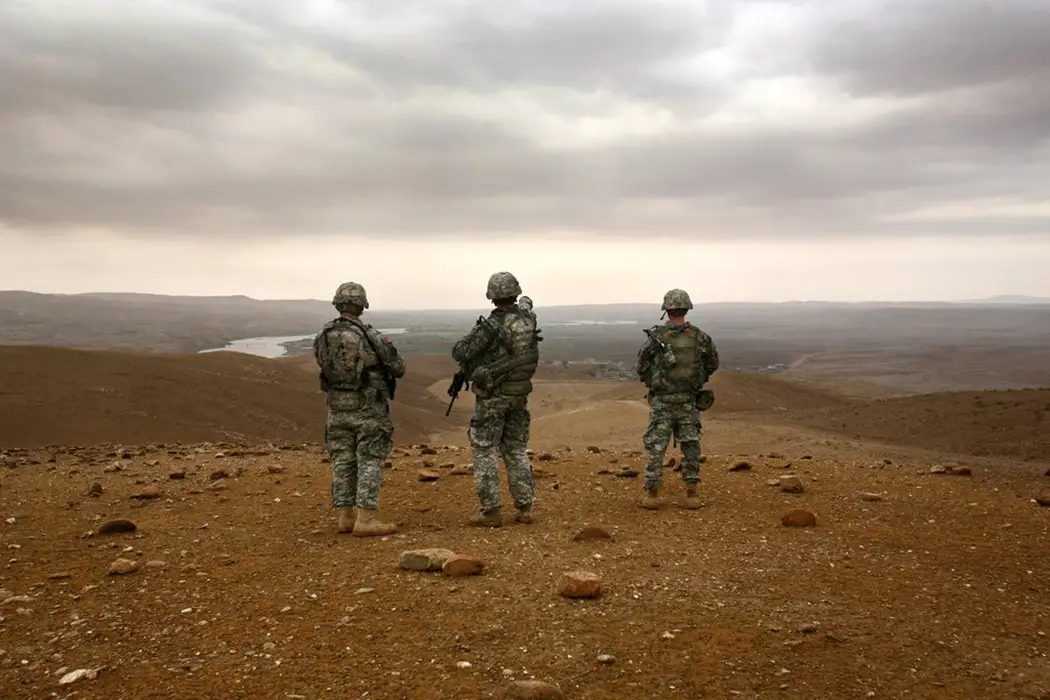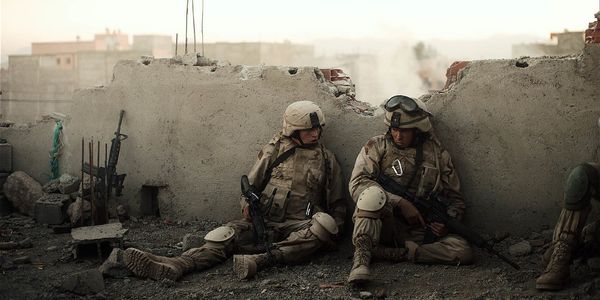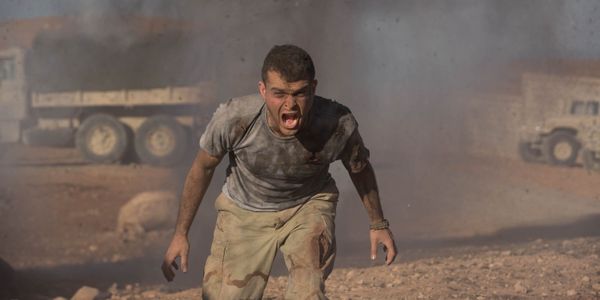THE YELLOW BIRDS: A Film At War With Itself

Tom is a recent graduate based in the UK, who…
The Yellow Birds is an intense and beautiful ode to human relationships in wartime – but is virtually indistinguishable from any other war film.
The film follows Bartle and Murphy, played by a pre-Han Solo Alden Ehrenreich and Tye Sheridan respectively, who make friends before going to war in Iraq. Upon his return, Bartle finds himself haunted by a promise he made to Murphy’s mother before deployment, and the various events that occurred whilst they were away.
Contemporary war films have a problem that films about other wars have never had. Whilst classic films about Vietnam, like Platoon or Full Metal Jacket, or the World Wars, such as Saving Private Ryan or The Great Escape had the added benefit of hindsight, contemporary war films are being released whilst the war is still going on.
This means that a film must interact not only with the cinematic canon and narrative of the event but with the actual current event – something the aforementioned films avoided. The Yellow Birds stumbles in trying to engage with the real-life event and the emotions it evokes in those involved – by doing so, it forgets that there is a plethora of existing films that also depict the war. It’s an intense and engaging film, but there are very few things it attempts that haven’t been done by war films before.
Shoot to Kill
The Yellow Birds premiered at the Sundance Film Festival, where it was awarded the U.S. Dramatic Special Jury Award for Cinematography, and it’s not hard to see why. Cinematographer David Landin knows exactly how to reflect the emotions and tensions of each scene in what he shoots, and it undoubtedly elevates the material significantly.
Wide shots used in Iraq emphasise the desolation and loneliness of the war-torn land, and the use of intense close-ups during firefights – and, interestingly, difficult conversations with grieving parents – translates the adrenaline and fear of the situations effectively onto the screen.
When the soldiers are travelling or patrolling in Iraq, Landin uses shots that emphasise futility and mystery of the journey – often the destination they are approaching is obscured by precise camera work, and the use of distant wide shots for these journeys brings out the natural patterns and quirks to the land.
The camerawork used for particular conversations, such as when Bartle’s mother is approached by an army worker at her home, is interesting for its similarities to scenes of combat. In both, one participant is obscured and hard to see; the other is out in the open, and the camera focuses on them and every facial expression they betray. The way Landin compares these two interactions through his camerawork beautifully depicts the relationships and attitudes of the characters.

If there were no script at all, Landin’s camerawork would still tell a riveting story, but as it is every choice emphasises the tones already present in the scene. The cinematography awards the film has garnered are all deserved.
Not quiet on the home front
To discuss any important element of the story, the middle and end to it must be spoiled. The story of The Yellow Birds is at its most interesting when Bartle returns from the war without Murphy. Murphy’s mother, portrayed by a surprisingly marvellous Jennifer Aniston, can’t get anyone from the army to tell her what happened to her son, and turns to an increasingly self-destructive Bartle to answer her questions.
The second act of the story plays out almost like a detective film – Murphy’s mother must pursue any lead she can to understand the slowly unravelling mystery of her son, while trying to slow Bartle’s descent in any way she can.
On the topic of Bartle – Ehrenreich gives a suitably restrained and quiet performance. This suits the character well, although given the news that Solo had a postponed release due to him needing acting lessons, this performance seems a little less intentional.

Whilst the second act is slow – Murphy’s mother’s struggle to find information makes the pacing a suitably excruciating doldrums – when Bartle breaks near the end of the film and reveals the fate of Murphy, the film really hits its stride. The contrasts between the past and present, and between the surviving Bartle and the fate of Murphy, are emphasised in some neat editing that emphasises the theme of the horrors of war. The final reveal is suitably heartwrenching and surprising.
It’s a shame that so many critics have viewed the film as a war film instead of a mystery – as the former it is fine, but as the latter it really stands out with its pacing and effective reveal. It seems as though director Alexandre Moors also had trouble making the distinction, which leads to some of the film’s problems.
Firing the cinematic cannon
The main detractor for The Yellow Birds, the thing that stops it being really great, is in its interactions with other films that have explored modern warfare, such as The Hurt Locker or Jarhead. In particular, the film fails to explore themes that haven’t already been explored by these films, and so never rises above to find its own identity.

Themes present in the film, such as the horrors of war or the troubled relationship between those who have fought in the war and their families, are two themes which are explored in nearly every war film – at this point they are becoming rather trite. These are two of the main themes of The Yellow Birds.
It’s a shame that these themes are so prominent through the film – the story is a truly interesting and profound one, and a script that leaned into the themes it presents a little more instead of the war clichés would have found a much more appreciating audience.
The Yellow Birds: Conclusion
The Yellow Birds is based on a novel of the same name by Kevin Powers, a veteran of the war, and it works as a mouthpiece for Powers’ fury at the disconnect between the war and the US military, and the normal civilians of the US who pay the war no dues. It’s ironic, therefore, that most of the criticisms of the film are that it is too preoccupied with war and other war films.
In part, this anger comes through – Bartle’s anger at the world he returns to is likely born from a spirit similar to Powers’, and the woes of military families speaks to these ideas. Yet by grounding the film too far into a Hollywood-driven view of war, Moors manages to lose the interest of those it was intended to reach in the first place.
The Yellow Birds is an interesting and engaging film, and has a lot in common with other wartime adventures made after the wars in question, such as The Monuments Men or Three Kings, than it does with its contemporaries. It’s received a fair amount of negative response for its allegiance to the cinematic canon, but The Yellow Birds is more than the sum of other films’ parts and makes for a worthwhile adventure.
How could filmmakers re-invent the contemporary war film?
Does content like this matter to you?
Become a Member and support film journalism. Unlock access to all of Film Inquiry`s great articles. Join a community of like-minded readers who are passionate about cinema - get access to our private members Network, give back to independent filmmakers, and more.
Tom is a recent graduate based in the UK, who writes about films and games, and makes a few of his own. If he's not watching a film, playing a game or writing a script - don't worry! - he's probably just gone to make a cup of tea. He's never far from a screen.












